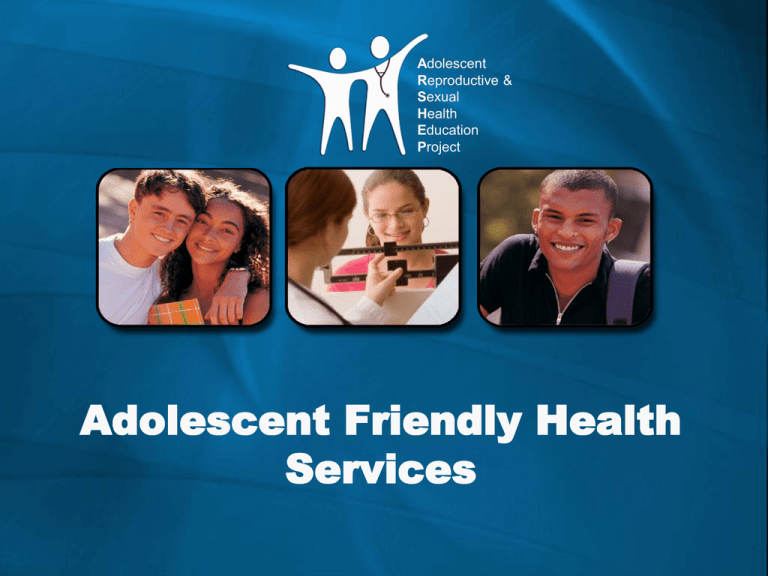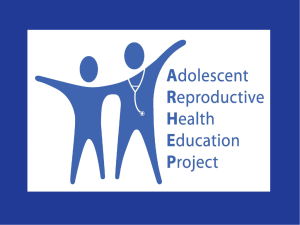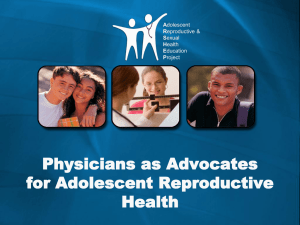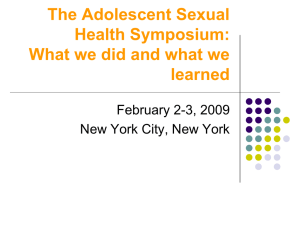
Adolescent
Reproductive &
Sexual
Health
Education
Project
Adolescent Friendly Health
Services
AdolescentMODULE
FriendlyTITLE
Health Services
Outline
Barriers to healthcare faced by
adolescents
Adolescent-friendly health services
Essentials of communication
“HEEADSSS”
Cases
PRCH 2012
AdolescentMODULE
FriendlyTITLE
Health Services
Objectives
By the end of this presentation,
participants will be able to:
Identify three key barriers to
healthcare access faced by
adolescents.
Describe three elements of
adolescent-friendly health services.
Utilize the HEEADSSS model of
patient interviewing.
PRCH 2012
AdolescentMODULE
FriendlyTITLE
Health Services
Adolescents
For the most part, adolescents
are:
Healthy.
Resilient.
Independent yet vulnerable.
Adolescents are not:
Big children.
Little adults.
PRCH 2012
AdolescentMODULE
FriendlyTITLE
Health Services
The Culture of
Adolescence
Peer dependent
Egocentric
Distinct language and dress
Popular culture influence
Ongoing search for identity
PRCH 2012
AdolescentMODULE
FriendlyTITLE
Health Services
Why Focus on
Adolescent Health?
Reduce death and disease, now and for the
rest of their lives
Fulfill the rights of adolescents to
healthcare, especially reproductive
healthcare
Increase the chances for healthy adulthood
PRCH 2012
AdolescentMODULE
FriendlyTITLE
Health Services
Early Adolescence
11–14
Characterized by a spurt of
growth
Beginning of sexual
maturation
Start to think abstractly
PRCH 2012
AdolescentMODULE
FriendlyTITLE
Health Services
Middle Adolescence
15–17
Physical changes of puberty are
complete
Develop a stronger sense of
identity and relate more strongly
to peer group
Thinking becomes more
reflective
PRCH 2012
AdolescentMODULE
FriendlyTITLE
Health Services
Late Adolescence
18 and older
The body continues
to develop and
takes adult form
Development of
distinct identity and
more settled ideas
and opinions
PRCH 2012
AdolescentMODULE
FriendlyTITLE
Health Services
External Barriers to Care
Perceived lack of confidentiality and
restrictions (parental consent/notification)
Poor communication by providers
Insensitive attitudes of care providers
Lack of provider knowledge and skills
Lack of money, insurance, and transportation
Inaccessible locations and/or limited services
Limited office hours
PRCH 2012
AdolescentMODULE
FriendlyTITLE
Health Services
External Barriers: Lack
of Insurance
75,040 children under the age of
18 lack health insurance.
29,313 youths ages 18–24 are
uninsured.
The risk of being uninsured historically
doubled when a teen turned 19.
Affordable Care Act allows young adults to
stay on parent’s health care plan until age 26.
PRCH 2012
AdolescentMODULE
FriendlyTITLE
Health Services
Lack of Insurance = Lack of Care
Insured adolescents visit a physician’s
office twice as often as uninsured
teens.
In a 1997 survey of adolescent girls:
50% of uninsured girls reported
foregoing needed care.
More than twice the rate of insured
girls
PRCH 2012
AdolescentMODULE
FriendlyTITLE
Health Services
Adolescent-Friendly
Health Services Include:
Establishing a comfortable, confidential, safe
space maintained by office staff and providers.
Communicating respectfully and appropriately.
Screening for high-risk behavior.
Awareness of how:
ability, age, culture, gender identity, sexual
orientation, religion, socioeconomic status,
can affect an adolescent’s reproductive
health.
PRCH 2012
AdolescentMODULE
FriendlyTITLE
Health Services
Adolescent Friendly Services:
Adolescent-specific
Multi- and
interdisciplinary
Accessible
Financially
affordable
Adolescent-focused
materials on display
Peer educator
component
Adequate space
Confidential
Flexible scheduling
Comprehensive
services
Continuity of care
Help transitioning
into the adult
medical care system
PRCH 2012
Adolescent Friendly Health Services
Preparing for Clinical
Visits
PRCH 2012
AdolescentMODULE
FriendlyTITLE
Health Services
Discuss Confidentiality in
Advance
Inform parents about confidentiality policy
before visit.
Letter home:
Detail when parent will be included in
clinical visit and when not.
Discuss billing issues.
Display materials such as posters or
brochures discussing importance of
doctor/patient confidentiality (See packet
for examples).
PRCH 2012
OUR POLICY ON CONFIDENTIALITY
Our discussions with you are private. We hope
that you feel free to talk openly with us about
yourself and your health. Information is not
shared with other people unless we are
concerned that someone is in danger.
Sample statement developed by URMC Department of Pediatrics
AdolescentMODULE
FriendlyTITLE
Health Services
Develop Referral Network
Social worker
Nutritionist
Psychologist or counselor
Abortion, adoption, and prenatal care
services
STD clinics
Department of Health clinics
PRCH 2012
Adolescent Friendly Health Services
The Clinical Interview
PRCH 2012
AdolescentMODULE
FriendlyTITLE
Health Services
Comprehensive
HEEADSSS
H: Home
E: Education/Employment
E: Exercise/Eating
A: Activities
D: Drugs
S: Suicidality/Depression
S: Sexuality
S: Safety
*Additional questions:
Strengths, Spirituality
PRCH 2012
AdolescentMODULE
FriendlyTITLE
Health Services
Utilizing HEEADSSS
Time limitations make model difficult
Can use written questionnaire in
waiting room
Provider should follow up on answers
drawing concern
PRCH 2012
AdolescentMODULE
FriendlyTITLE
Health Services
Other Clinical Interview
Tools
GAPS: AMA Guidelines for Adolescent
Preventive Services
Bright Futures: Collaboration between AAP
and Bureau of Maternal Child Health Care
Trigger Questionnaire: Developed by Office
of Managed Care in the New York State
Department of Health
ACOG Tool Kit: Designed by the ACOG
Committee on Adolescent Health Care to
help every office care for adolescent patients
PRCH 2012
AdolescentMODULE
FriendlyTITLE
Health Services
Home
PRCH 2012
AdolescentMODULE
FriendlyTITLE
Health Services
US Children:
Home Demographics, 2007
27% live with families where no parent
has full-time, year-round employment
34% live in single-parent households
20% live in poverty
24% of 18–24 year olds live in poverty
PRCH 2012
AdolescentMODULE
FriendlyTITLE
Health Services
Home
Who lives in the home with you?
How are your relationships with siblings,
parents, other relatives?
Who do you go to for advice?
What are the rules like at home?
Is there a gun in your home?
Ever been homeless or in shelter care?
Ever been in foster care or group home?
PRCH 2012
AdolescentMODULE
FriendlyTITLE
Health Services
Education and Employment
PRCH 2012
AdolescentMODULE
FriendlyTITLE
Health Services
Education and Employment
In 2009, of U.S. eighth graders:
29% scored below basic math level
26% scored below basic reading level
Since 2008:
9% of teens not attending school and not
working
14% of 18–24 year olds not attending
school, not working, a high school degree
PRCH 2012
AdolescentMODULE
FriendlyTITLE
Health Services
Education
What is the name of your school and what
grade are you in?
What kind of student are you?
How many days have you missed in the
past year and what was the reason?
Have you ever had any educational
setbacks? Why?
Have there been any recent school
changes?
What are your educational and life goals?
PRCH 2012
AdolescentMODULE
FriendlyTITLE
Health Services
Employment
Do you work after school?
What type of work do you do?
How many hours a week?
Do you help to pay for things at home?
What are your future career interests?
Do you have any home chores?
Allowance?
PRCH 2012
Exercise and Eating
AdolescentMODULE
FriendlyTITLE
Health Services
US High School Students:
Weight, 2011 YRBS
100%
90%
80%
70%
60%
50%
40%
30%
20%
10%
0%
Male
Female
34.8%
23.9%
16.1%
9.8%
Obese
15.1%
15.4%
Are Overweight
Describe Selves as
Overweight
PRCH 2012
AdolescentMODULE
FriendlyTITLE
Health Services
Controlling Weight,
2009 and 2011 YRBS
100%
90%
80%
70%
60%
50%
40%
30%
20%
10%
0%
Male
Female
59.3%
30.5%
6.9%
14.5%
Were Trying to Lose Went 24 hours
Weight (2009 data) w/out Eating (2009
data)
4.2% 5.9%
2.5% 6.0%
Took Diet Pills
Vomited or Took
Laxatives
PRCH 2012
AdolescentMODULE
FriendlyTITLE
Health Services
Exercise Behaviors,
2011 YRBS
28.7% met recommended
levels of physical activity
48.2% attended physical
education less than once per
week
PRCH 2012
AdolescentMODULE
FriendlyTITLE
Health Services
Exercise/Eating
Body image:
What is your ideal weight?
What do you like about yourself?
Calcium, iron, fiber in diet?
How many meals do you eat per day?
Bowel movement pattern and problems?
Thin: Do you exercise, ever vomited, used
diuretics, laxatives?
Overweight: Do you drink soda/juice, whole
milk? Exercise? TV?
PRCH 2012
AdolescentMODULE
FriendlyTITLE
Health Services
Activities
PRCH 2012
AdolescentMODULE
FriendlyTITLE
Health Services
Activities, 2011 YRBS:
58.4% reported having played on a
sports teams in the past 12
months
32.4% reported watching 3 or
more hours of television per day
31.1% reported using a computer
3 or more hours/ day
PRCH 2012
AdolescentMODULE
FriendlyTITLE
Health Services
Activities
How do you like to spend your free
time?
Hobbies, clubs, religious/spiritual
activities?
Do you play any sports?
How many hours of television/computer
per day? Per week?
PRCH 2012
AdolescentMODULE
FriendlyTITLE
Health Services
Drug and Alcohol Use
PRCH 2012
AdolescentMODULE
FriendlyTITLE
Health Services
Substance Use, 2011
YRBS:
Ever Used:
70.8% drank alcohol
21.9% reported episodic heavy drinking
39.9% used marijuana
11.4% inhalants
8.2% ecstasy
6.8% cocaine
3.8% methamphetamines
PRCH 2012
AdolescentMODULE
FriendlyTITLE
Health Services
Drugs and Alcohol
Does anyone you hang out with smoke,
drink, or use drugs? Do you?
How frequently and how much?
Do you smoke or chew tobacco?
Do you use anabolic steroids?
Do you drink alcohol?
What kind: beer, wine, hard liquor?
Any blackouts? Ever pass out? Vomit?
PRCH 2012
AdolescentMODULE
FriendlyTITLE
Health Services
Drugs and Alcohol
Do you use any illicit drugs?
Marijuana, inhalants, cocaine, crack, heroin,
pills, LSD, ecstasy, crystal meth, other drugs?
Ever do anything you have regretted while high?
Context of use: socially, alone, how often?
Attitudes toward cutting back and/or quitting?
Ever received drug treatment or counseling?
How is your drug use supported?
Have you ever had any arrests?
PRCH 2012
AdolescentMODULE
FriendlyTITLE
Health Services
CRAFFT Questions:
Identify Problem Use
Have you ever ridden in a Car driven by someone
who was high or had been using alcohol or drugs?
Do you ever use alcohol or drugs to Relax, feel
better about yourself, or fit in?
Do you ever use drugs or alcohol when you are
Alone?
Do you Forget things while using drugs or alcohol?
Do your family or Friends ever tell you that you
should cut down on your drinking or drug use?
Have you ever gotten into Trouble while using
drugs or alcohol?
Copyright © Children's Hospital Boston. All rights reserved
PRCH 2012
AdolescentMODULE
FriendlyTITLE
Health Services
Depression and
Suicidality
PRCH 2012
AdolescentMODULE
FriendlyTITLE
Health Services
Depression and Suicidality,
2011 YRBS:
100%
90%
80%
70%
60%
50%
40%
30%
20%
10%
0%
Male
Female
35.9%
21.5%
12.5%
Felt Sad or
Hopeless
19.3%
10.8%
15.0%
5.8%
9.8%
Seriously
Made Suicide Plan Attempted Suicide
Considered Suicide
1 or more Times
PRCH 2012
AdolescentMODULE
FriendlyTITLE
Health Services
Depression/Suicidality
What is your usual mood: happy, sad, both?
What do you do to cope with or relieve stress?
Have you ever received counseling and/or
therapy?
Have you ever been in a psychiatric hospital?
What was the reason?
How long did you stay?
Have you ever thought of hurting yourself?
Have you ever tried to hurt or kill yourself?
PRCH 2012
Whom did you tell?
AdolescentMODULE
FriendlyTITLE
Health Services
Sexuality
PRCH 2012
Sexual Orientation
Sexual Attraction
Sexual Behavior
Paradigm of
Sexuality
Biological Sex
Gender Identity
AdolescentMODULE
FriendlyTITLE
Health Services
Sexual/Reproductive
Health History
Menstrual history
Number of lifetime
sexual partners
Sexual orientation
Number of partners in
Gender identity
last 3–6 months
Age at first intercourse
History of STIs
Vaginal, oral, anal sex
Sexual satisfaction
history
History of survival sex,
Contraceptive history
sexual victimization,
Pregnancy history
unwanted or coerced
sex
Timing of childbearing
plans
PRCH 2012
AdolescentMODULE
FriendlyTITLE
Health Services
Sexual Behavior
Questions
Don’t
Do
Ask “Are you sexually
active?”
Assure confidentiality
Explain why you are
asking sensitive questions
Use gendered-biased
pronouns when referring Ask patient to describe
to sexual partners
specific sexual behaviors
Use judgmental language Add “second tier”
questions to assess
Use slang unless patient
comfort with behaviors
offers it first
PRCH 2012
AdolescentMODULE
FriendlyTITLE
Health Services
Identifying Sexual
Minority Youth
Actual prevalence of gay, lesbian, bisexual
(GLB), transgender, and questioning is
unknown
PRCH 2012
AdolescentMODULE
FriendlyTITLE
Health Services
2011 Vermont Youth Risk
Behavior Survey
Heterosexual
Not sure
3%
Bisexual
Homosexual
1%
4%
92%
PRCH 2012
AdolescentMODULE
FriendlyTITLE
Health Services
Sexual Orientation & Adolescents:
Growing Up Today Study (’97–’03)
Heterosexual
1.5%
Mostly heterosexual
Males N=5700
0.2%
1.0%
Bisexual
Gay/Lesbian
0.7%
2.7%
Not sure
Females
N= 7750
0.3%
6.0%
12.6%
91.3%
Corliss H, et al. Arch Pediatr Adolesc Med. 2008;162(11):1071–1078.
83.5%
PRCH 2012
AdolescentMODULE
FriendlyTITLE
Health Services
Assessing Gender
Identity
Do you think of yourself as male, female,
neither, or both?
What pronoun do you use (she, he, they,
sie*)?
Are you comfortable with your feelings?
How do you think your
parents/teachers/friends would react
(have reacted) to your gender identity?
*Sie is a gender neutral pronoun sometimes used by members of the transgender
community
PRCH 2012
AdolescentMODULE
FriendlyTITLE
Health Services
Assessing Sexual
Orientation
Are you romantically interested in men,
women, or both?
Are you comfortable with your
feelings?
Have you ever had sex with someone of
your same gender?
For younger teens: when you imagine
yourself in a relationship in the future is it
with a man, a woman, or both?
PRCH 2012
AdolescentMODULE
FriendlyTITLE
Health Services
Discussing Sexual and
Romantic Relationships
Have you ever had a crush on a boy or
girl? What was that like?
Have you ever had a romantic relationship
with someone?
How would you describe it?
PRCH 2012
AdolescentMODULE
FriendlyTITLE
Health Services
Assessing the Health of
the Relationship
What does a healthy relationship look like to you?
• Disagreements and arguments are a normal part of any
intimate relationship. What is it like when you and your
partner get into an argument? How do you usually
resolve it?
• How often are you and your partner together? How does
you partner feel about you hanging out with other
friends?
• (If sexually active) Who makes the decisions about when
to have sex and if or what kind of contraceptives you
should use?
•
PRCH 2012
AdolescentMODULE
FriendlyTITLE
Health Services
Characteristics of a
Healthy Relationship
Non-violent conflict resolution
Open and honest communication
Right to autonomy for both people
Shared decision-making
Trust
Mutual respect
Individuality
Empathy
PRCH 2012
AdolescentMODULE
FriendlyTITLE
Health Services
Risk factors for unhealthy
relationships
Partner is 3-5 years older
Exposure to violence in the household or
community
Early sexual activity
Low education level
Sexual risk taking
Substance abuse
PRCH 2012
AdolescentMODULE
FriendlyTITLE
Health Services
Assessing Sexual
Behavior
How old were you when you first had sex?
(Include anal, oral, and vaginal.)
What was the date of your last intercourse?
What kind of protection did you use at last sex?
Condoms? Hormonal contraception?
Do you have a current partner?
How long have you been with your partner?
How many sexual partners have you had?
How many sexual partners have you had in the
past three months? Six months? Lifetime?
PRCH 2012
AdolescentMODULE
FriendlyTITLE
Health Services
Sexual Satisfaction
How often do you have pain during
sexual intercourse or other sexual
activities?
Are you satisfied with how often you
have sexual relations and with what
you do with your sexual partner?
Any problems becoming aroused,
getting an erection, getting lubricated
(wet), or having an orgasm?
PRCH 2012
AdolescentMODULE
FriendlyTITLE
Health Services
Sexual Health
Have you ever had any STIs?
Do you know what the symptoms of STIs
are? Tell me.
Have you ever been tested for an STI?
Have you ever been pregnant or gotten
anyone pregnant? What were the
outcomes?
Do you have any concerns about fertility?
When (if ever) would you like to have
children?
PRCH 2012
AdolescentMODULE
FriendlyTITLE
Health Services
Safety
PRCH 2012
AdolescentMODULE
FriendlyTITLE
Health Services
Sexual/Dating Violence
2011 YRBS:
100%
90%
Male
80%
Female
70%
60%
50%
40%
30%
20%
10%
10.3%
9.3%
11.8%
4.5%
0%
Dating Violence (2009 Data)
Forced to Have Sexual Intercourse
PRCH 2012
AdolescentMODULE
FriendlyTITLE
Health Services
Drunk Driving, 2011 YRBS:
100%
90%
80%
70%
60%
50%
40%
30%
20%
10%
0%
Male
23.3%
Female
24.9%
9.5%
Rode w/ Driver Who Had Been
Drinking
6.7%
Drove When Drinking Alcohol
PRCH 2012
AdolescentMODULE
FriendlyTITLE
Health Services
Sexual and Physical
Abuse
Have you ever been forced to have sex or
been touched in a way against your will?
By whom and is this still going on?
Who did you tell?
How does it affect your day-to-day life?
In what ways does that experience
affect your sexual relationships now?
Has anyone ever hurt you on a repeated
basis? At home, in school, or in your
neighborhood?
PRCH 2012
AdolescentMODULE
FriendlyTITLE
Health Services
Interpersonal Violence
includes
Child abuse
Battering
Domestic violence
Partner violence
School, peer, community violence
Sexual harassment
Sexual abuse
Sexual assault
Hate crime
PRCH 2012
AdolescentMODULE
FriendlyTITLE
Health Services
Additional Safety
Concerns
Recreational safety: bicycle helmets,
protective sports gear, sunscreen use
Auto safety: riding in stolen car, in car
with drunk driver, in car late at night,
seatbelt use
PRCH 2012
AdolescentMODULE
FriendlyTITLE
Health Services
Spirituality
PRCH 2012
AdolescentMODULE
FriendlyTITLE
Health Services
Spirituality*
What do you consider to be your
religion?
How often do you participate in
religious activities?
How important are your spiritual
beliefs in your day-to-day life?
How do your beliefs influence your
health and attitudes about sex and
contraception?
PRCH 2012
AdolescentMODULE
FriendlyTITLE
Health Services
Strengths*
Assess healthy behaviors and resiliency
throughout the interview
Identify past difficulties that have been
overcome
Provide positive feedback and balance to
the interview
PRCH 2012
AdolescentMODULE
FriendlyTITLE
Health Services
Case 1:
A 15-year-old female patient
comes to your office. You
notice that she has gained a
bit of weight. When you ask
her to stand on the scale, she
begins to cry.
What questions do you ask
her regarding her health and
body weight?
How do you approach the
subject sensitively?
PRCH 2012
AdolescentMODULE
FriendlyTITLE
Health Services
Case 2:
A 14-year-old female enters
your office with her mother.
To every question you ask
the young woman, the mother
offers a response. Your
patient seems shy and rather
uncomfortable.
How do you proceed with
this visit?
PRCH 2012
AdolescentMODULE
FriendlyTITLE
Health Services
Case 3:
You have recently accepted a new
position as practitioner at a pediatric
office. The clinic sees a small
population of adolescents but wishes
to expand its efforts with this
population.
What are some initial steps that you
take to ensure that your office is
adolescent friendly?
PRCH 2012
AdolescentMODULE
FriendlyTITLE
Health Services
Please Complete Your
Evaluations Now
PRCH 2012
AdolescentMODULE
FriendlyTITLE
Health Services
Provider Resources
www.prch.org—Physicians for Reproductive Choice and Health
www.aap.org—The American Academy of Pediatrics
www.acog.org—The American College of Obstetricians and
Gynecologists
www.adolescenthealth.org—The Society for Adolescent Health
and Medicine
http://www.aclu.org/reproductiverights—The Reproductive Freedom
Project of the American Civil Liberties Union
www.advocatesforyouth.org—Advocates for Youth
www.guttmacher.org—Guttmacher Institute
www.cahl.org—Center for Adolescent Health and the Law
www.gynob.emory.edu/centers/jfc—The Jane Fonda Center of
Emory University
www.siecus.org—The Sexuality Information and Education
Council of the United States
www.arhp.org—The Association of Reproductive Health
Professionals
PRCH 2012
AdolescentMODULE
FriendlyTITLE
Health Services
Provider Resources
PRCH’s Minors’ Access to Confidential Reproductive
Healthcare Cards and Emergency Contraception: A
Practitioner’s Guide
ARHP’s Reproductive Health Model Curriculum
AMA Guidelines for Adolescent Preventive Services
(GAPS)
The American College of Obstetricians and
Gynecologists:
Confidentiality in Adolescent Health Care
Primary and Preventive Health Care for Female Adolescents
Tool Kit for Teen Care—available at:
www.acog.org/bookstore/Tool_Kit_for_Teen_Care_P348C84.cfm
For emergency contraception: www.not-2-late.com
PRCH 2012










